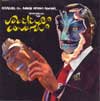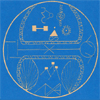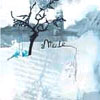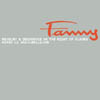 How the mighty have fallen. Not that Andre Afram Asmar might really beconsidered mighty, but his last record for Mush was a beautiful mashupof hip-hop and middle eastern instrumentals that worked on any numberof levels and preserved a sense of genuine respect for all of thesounds it culled. Enter Circus, the MC who manages to take AAA'sproduction and run it into the ground with half-witted rhymes and adeadpan vocal delivery that recalls a suburban, middle-agedbusinessperson reciting a 'rap' in some corporate skill-buildingseminar. The album has a loose theme that revolves around alienabduction, conspiracy theories, and the Bush administration'swar-waging in the middle east. Unfortunately, the serious themes andstupid themes are given just about equal billing, but its all played ina straight-faced way to render none of it funny or effective. The beatsand samples that Circus drowns out might be worthwhile on their own,but it's impossible to separate the voice from the songs. I'll neverquite understand how people who have an ear for quality music and deftMCs can listen to something like Gawd Bless the Faceless Cowardsand feel that it's adequate or even fun to listen to. Inane rhymesdelivered flatly over beats and samples about UFOs might make for a funparty record amongst friends, but only really close friends who aren'ttoo critical, or who are really drunk. Someone got in the car with mewhen this record was on and the first question he asked was 'is this ademo someone sent you?' No, but maybe if someone had heard the demofirst, they could have steered it somewhere productive. As it is, steerclear.
How the mighty have fallen. Not that Andre Afram Asmar might really beconsidered mighty, but his last record for Mush was a beautiful mashupof hip-hop and middle eastern instrumentals that worked on any numberof levels and preserved a sense of genuine respect for all of thesounds it culled. Enter Circus, the MC who manages to take AAA'sproduction and run it into the ground with half-witted rhymes and adeadpan vocal delivery that recalls a suburban, middle-agedbusinessperson reciting a 'rap' in some corporate skill-buildingseminar. The album has a loose theme that revolves around alienabduction, conspiracy theories, and the Bush administration'swar-waging in the middle east. Unfortunately, the serious themes andstupid themes are given just about equal billing, but its all played ina straight-faced way to render none of it funny or effective. The beatsand samples that Circus drowns out might be worthwhile on their own,but it's impossible to separate the voice from the songs. I'll neverquite understand how people who have an ear for quality music and deftMCs can listen to something like Gawd Bless the Faceless Cowardsand feel that it's adequate or even fun to listen to. Inane rhymesdelivered flatly over beats and samples about UFOs might make for a funparty record amongst friends, but only really close friends who aren'ttoo critical, or who are really drunk. Someone got in the car with mewhen this record was on and the first question he asked was 'is this ademo someone sent you?' No, but maybe if someone had heard the demofirst, they could have steered it somewhere productive. As it is, steerclear.
- Administrator
- Albums and Singles
 How the mighty have fallen. Not that Andre Afram Asmar might really beconsidered mighty, but his last record for Mush was a beautiful mashupof hip-hop and middle eastern instrumentals that worked on any numberof levels and preserved a sense of genuine respect for all of thesounds it culled. Enter Circus, the MC who manages to take AAA'sproduction and run it into the ground with half-witted rhymes and adeadpan vocal delivery that recalls a suburban, middle-agedbusinessperson reciting a 'rap' in some corporate skill-buildingseminar. The album has a loose theme that revolves around alienabduction, conspiracy theories, and the Bush administration'swar-waging in the middle east. Unfortunately, the serious themes andstupid themes are given just about equal billing, but its all played ina straight-faced way to render none of it funny or effective. The beatsand samples that Circus drowns out might be worthwhile on their own,but it's impossible to separate the voice from the songs. I'll neverquite understand how people who have an ear for quality music and deftMCs can listen to something like Gawd Bless the Faceless Cowardsand feel that it's adequate or even fun to listen to. Inane rhymesdelivered flatly over beats and samples about UFOs might make for a funparty record amongst friends, but only really close friends who aren'ttoo critical, or who are really drunk. Someone got in the car with mewhen this record was on and the first question he asked was 'is this ademo someone sent you?' No, but maybe if someone had heard the demofirst, they could have steered it somewhere productive. As it is, steerclear.
How the mighty have fallen. Not that Andre Afram Asmar might really beconsidered mighty, but his last record for Mush was a beautiful mashupof hip-hop and middle eastern instrumentals that worked on any numberof levels and preserved a sense of genuine respect for all of thesounds it culled. Enter Circus, the MC who manages to take AAA'sproduction and run it into the ground with half-witted rhymes and adeadpan vocal delivery that recalls a suburban, middle-agedbusinessperson reciting a 'rap' in some corporate skill-buildingseminar. The album has a loose theme that revolves around alienabduction, conspiracy theories, and the Bush administration'swar-waging in the middle east. Unfortunately, the serious themes andstupid themes are given just about equal billing, but its all played ina straight-faced way to render none of it funny or effective. The beatsand samples that Circus drowns out might be worthwhile on their own,but it's impossible to separate the voice from the songs. I'll neverquite understand how people who have an ear for quality music and deftMCs can listen to something like Gawd Bless the Faceless Cowardsand feel that it's adequate or even fun to listen to. Inane rhymesdelivered flatly over beats and samples about UFOs might make for a funparty record amongst friends, but only really close friends who aren'ttoo critical, or who are really drunk. Someone got in the car with mewhen this record was on and the first question he asked was 'is this ademo someone sent you?' No, but maybe if someone had heard the demofirst, they could have steered it somewhere productive. As it is, steerclear.Read More
 Some of my favorite releases of the last year or so come from the US indie hip-hop contender, Mush. Their recent find, a Japanese import called Neutrino, is being sent out with a sticker comparing the release to DJ Krush, claiming that Krush isn't the only player in Japan's instrumental hip-hop scene. That may be true, but Krush is still a few moves ahead of the rest of the pack if Neutrino's eponymous release is any indication.
Some of my favorite releases of the last year or so come from the US indie hip-hop contender, Mush. Their recent find, a Japanese import called Neutrino, is being sent out with a sticker comparing the release to DJ Krush, claiming that Krush isn't the only player in Japan's instrumental hip-hop scene. That may be true, but Krush is still a few moves ahead of the rest of the pack if Neutrino's eponymous release is any indication.
- Administrator
- Albums and Singles
 Some of my favorite releases of the last year or so come from the US indie hip-hop contender, Mush. Their recent find, a Japanese import called Neutrino, is being sent out with a sticker comparing the release to DJ Krush, claiming that Krush isn't the only player in Japan's instrumental hip-hop scene. That may be true, but Krush is still a few moves ahead of the rest of the pack if Neutrino's eponymous release is any indication.Mush
Some of my favorite releases of the last year or so come from the US indie hip-hop contender, Mush. Their recent find, a Japanese import called Neutrino, is being sent out with a sticker comparing the release to DJ Krush, claiming that Krush isn't the only player in Japan's instrumental hip-hop scene. That may be true, but Krush is still a few moves ahead of the rest of the pack if Neutrino's eponymous release is any indication.Mush
The tracks are classic Mush: slow and moody with a nod to hip-hop and jazz record sampling, but with a sophisticated touch and layered production style. These don't sound like tracks in search of an MC, but rather they function as whole songs on their own. For nodding background music or the score to a student film about 'urban landscapes', Neutrino is just fine. There's enough warmth and depth to the compositions that they held up to repeat spins as I drove around town and then set up my wireless network at home. However, whenever I tried to focus on the album, it seemed to be built on an all-too-familiar set of rules and loops. It's groovy downtempo stuff, no doubt, but it fails to capture the imagination the way last year's Villain Accellerate record did. This is polite and tidy beat-making, with windchime accents, chirping bird samples and the occassional disembodied voice-snippet that almost lend it a depth worth exploring more. With a shelf full of exceptional releases from other Mush artists, as well as their forebears like the aforementioned DJ Krush, DJ Shadow, and almost all of the early Ninja Tune stable, it's difficult to make room for Neutrino, though he does make enough of a case for giving it a try. 
Read More
- Administrator
- Albums and Singles
 Glitchy electronic music about the problems people face in a modernsociety from a husband and wife team sounds frighteningly close to aWill Ferrell-based SNL skit, but this new EP fits that description, andthe results are ripe for absorption.
Glitchy electronic music about the problems people face in a modernsociety from a husband and wife team sounds frighteningly close to aWill Ferrell-based SNL skit, but this new EP fits that description, andthe results are ripe for absorption. Clairecords
Keyboards and vocals by JeannetteFaith are the base, and then Wes Steed takes it to a whole other levelwith computers and homemade synths, resulting in a sound that is notjust songs, it's a whole atmosphere. The techniques are used to greateffect in creating a feeling of absolute detachment, like a dependenceon computers for everything in life just so it doesn't require effort.The titles could be articles in Reader's Digestor some corporate pamphlet, and as such they belie the elegance ofwhat's inside. When sounds escape the speakers, though, the mood isrealized immediately, and an almost menial state of mind takes shape,like drone-esque office work. Troubadours used to sing about thestruggle of the working man #&151; farmers, mechanics, factoryworkers — in angry tones meant to seize attention and changeperceptions. This music is about the new under-appreciated orendangered species due to workload or stress at work or at home: thedesk jockey. Rather than knock people out with brute force, this is acoaxing way of encouraging results. This is a new step for the duo,since their last album did not deal with themes anywhere near this, butthey are perfectly suited to the task. Lyrics like "how many red eyeshave you taken?" and "home is where the heart breaks" float out onFaith's processed voice, immediately cutting in and burrowing for along stay. This is a bubbly and cheery-sounding record on the surface,but beneath it there is pain and longing. I couldn't stop listening,and it is now the preferred soundtrack for my mundane day jobexistence. Maybe I'll find the hidden message and escape, and I thinkthat's exactly what these songs are meant to persuade the listenertowards.
Read More
- Administrator
- Albums and Singles
 The liner notes read "No computers or electricity were employed in themusic making process." How that is possible baffles me, so I figure itmust be a joke or a half-truth. On the other hand, how a record wasmade rarely matters to me more than how it comes out sounding and Rooting for the Microbesis a bit of a mixed bag in that respect.
The liner notes read "No computers or electricity were employed in themusic making process." How that is possible baffles me, so I figure itmust be a joke or a half-truth. On the other hand, how a record wasmade rarely matters to me more than how it comes out sounding and Rooting for the Microbesis a bit of a mixed bag in that respect.Load
A consistent barrage ofwailing scratches and interstellar waves covers up, for a majority ofthe album, strangely distorted natural sounds like accordians, bells,clocks, and laughter. This combination of failing equipment andindefinite references to some kind of ghost world run by clowns staysfairly interesting from beginning to start; but Nautical Alamanac'sformula rarely changes. The rigid structure of each song somehowbecomes apparent through all the smoke and noise half way through thealbum and makes the remainder feel like a repeat of the first filteredthrough some altered dimesion. I can't help but think that this randomassortment of sounds is somehow comedic at its heart, maybe just a bitsurrealist. The assault of scratches, wheezes, and whines are neverthreatening and, even at loud volumes, never inspire any kind ofmadness or unbearable torment. The spasmodic current of the album neverallows for a consistency to build; any residue left behind by one soundis immediately destroyed by the following. "Cross Dementia" doesnothing short of spread laughter and the closing "Ocularis" only windseverything down to a calm and and slightly more silent end. So what'smissing? When the hidden track(s?) finally end and I'm left sitting inmy room, I feel like Nautical Almanac forgot some important ingredientsin their noise soup. For all their wackiness, Nautical Almanac somehowmanages to tell the same joke over and over. Where another group orindividual might succeed in making nonsense noise by severely wideningthe sound palette, Nautical Almanac stays static, relying on thegimmick of "no computers, no electricity" (if that is actually thecase) to carry the album. It boils down to this: the noise just soundslike noise. It has no compositional value and just seems like ahindrance on some of the other sounds that are trying to be heard. Hadsome more variety been packed into the noise end of the album and thencombined with all those excellent samples of the recognizable world, Rooting for the Microbes would have come away a lot more addicting than it is now.
Read More
- Administrator
- Albums and Singles
 Good or bad, dark ambient albums rarely get much of a rise out of me.While I can usually appreciate an artist's attempts at creating acertain mood or feeling, I have heard enough "haunting sonictapestries" over the years that it takes a lot to impress me. The glutof releases from obviously untalented bedroom producers in this genrecertainly doesn't give a reason to get excited. While by no means arevolutionary work, As Giants Watch Over Us,the third Ad Noiseam release from James Keeler, benefits from itswillingness to use intrusive sounds among its more subdued spookydrones. "Empire Of The Snake" opens this lengthy album with ominoustextures peppered with sudden bursts and prolonged sections ofswirling, unruly synthesized noise. Breaking from this style, the titletrack exudes a type of frozen paranoia amid the screeching, voicesnippets, and sampled dramatic symphonies. "The Fiddler And The Fool"creeps along much like an updated version of a old horror movie score,shifting gears around three minutes in to dissonance and backwardsloops. The emotive and atmospheric "Reversing Magnetism" plays outbeautifully, with delayed and stretched tones morphing over clickingstatic and low bass. Running over 70 minutes long, at least a few ofthese thirteen somewhat similar tracks could have been whittled down orcut altogether. Nonetheless, both the Cold Meat Industry set as well assound design connoisseurs may find some reward from As Giants Watch Over Us.
Good or bad, dark ambient albums rarely get much of a rise out of me.While I can usually appreciate an artist's attempts at creating acertain mood or feeling, I have heard enough "haunting sonictapestries" over the years that it takes a lot to impress me. The glutof releases from obviously untalented bedroom producers in this genrecertainly doesn't give a reason to get excited. While by no means arevolutionary work, As Giants Watch Over Us,the third Ad Noiseam release from James Keeler, benefits from itswillingness to use intrusive sounds among its more subdued spookydrones. "Empire Of The Snake" opens this lengthy album with ominoustextures peppered with sudden bursts and prolonged sections ofswirling, unruly synthesized noise. Breaking from this style, the titletrack exudes a type of frozen paranoia amid the screeching, voicesnippets, and sampled dramatic symphonies. "The Fiddler And The Fool"creeps along much like an updated version of a old horror movie score,shifting gears around three minutes in to dissonance and backwardsloops. The emotive and atmospheric "Reversing Magnetism" plays outbeautifully, with delayed and stretched tones morphing over clickingstatic and low bass. Running over 70 minutes long, at least a few ofthese thirteen somewhat similar tracks could have been whittled down orcut altogether. Nonetheless, both the Cold Meat Industry set as well assound design connoisseurs may find some reward from As Giants Watch Over Us. Read More
- Administrator
- Albums and Singles
 This is an example of a full-length that perfectly, if predictably,fulfills my expectations. aMute's track on last year's Intr_versioncompilation formed the undeniable centerpiece of the disc. If not themost showy piece, it was certainly the most effective, dropping in frombehind the preceding track almost invisibly and, through gracefulcrescendos, sucking the entire sampler into its icy expanse, enough tohaunt the remainder of the disc and nearly summarize the label'smelancholic ethos in a eight short minutes. For his debut album, JérômeDeuson provides not only an extended version of that song, "Aux creuxdes vagues, mon visage," but also seven others that match its moodeasily, creating a work that seems cut from the same graying,crystalline tapestry, full of bristly folds and wide, smothering fuzz.Deuson's technique is nothing shocking, an intricate, but notover-complex entangling of effects-heavy guitar, processed feedbacknoise, and windy, chime-ful ambience, all allowed to dive and swoopthrough layers of minimal bass and the smallest of percussive clicks.None of the tracks are particularly grounded; rather they float in astructure-less haze that serves the cold, discreet passages conjured byaMute's harmonic sensibility, the same economized, somber aesthetic ofhis labelmates Joshua Treble, Mitchell Akiyama, and The Beans. Like hisfriends, Deuson's approach is geared away from bending his guitartowards extremes in distortion or processed disintegration and moretowards crafting careful, meaningful builds via simple melodic strandswith clear resolutions. The frosty ambiance, of scattered windchimesand stuttering drones, carries these tracks into the oblivion theyrequire; however, Deuson's playing maintains a directness that attachesa cinematic feel throughout. Certain left-field inclusions, likemuffled vocal samples and a track of naked French speech, add to thefeeling of remove that I (perhaps too quickly) tend to associate withsome set of fixed visual correspondents. This might form my onecriticism of A Hundred Day Trees,that, for all its sad majesty, the album seems a bit limited in itsexpressive power, leaving me in the same place after each listen. Itcould be the relative homogeneity of the tracks or the similarity toother recent releases by the label, not bad qualities at all, just notenough to prove that aMute doesn't have better in store for next time.
This is an example of a full-length that perfectly, if predictably,fulfills my expectations. aMute's track on last year's Intr_versioncompilation formed the undeniable centerpiece of the disc. If not themost showy piece, it was certainly the most effective, dropping in frombehind the preceding track almost invisibly and, through gracefulcrescendos, sucking the entire sampler into its icy expanse, enough tohaunt the remainder of the disc and nearly summarize the label'smelancholic ethos in a eight short minutes. For his debut album, JérômeDeuson provides not only an extended version of that song, "Aux creuxdes vagues, mon visage," but also seven others that match its moodeasily, creating a work that seems cut from the same graying,crystalline tapestry, full of bristly folds and wide, smothering fuzz.Deuson's technique is nothing shocking, an intricate, but notover-complex entangling of effects-heavy guitar, processed feedbacknoise, and windy, chime-ful ambience, all allowed to dive and swoopthrough layers of minimal bass and the smallest of percussive clicks.None of the tracks are particularly grounded; rather they float in astructure-less haze that serves the cold, discreet passages conjured byaMute's harmonic sensibility, the same economized, somber aesthetic ofhis labelmates Joshua Treble, Mitchell Akiyama, and The Beans. Like hisfriends, Deuson's approach is geared away from bending his guitartowards extremes in distortion or processed disintegration and moretowards crafting careful, meaningful builds via simple melodic strandswith clear resolutions. The frosty ambiance, of scattered windchimesand stuttering drones, carries these tracks into the oblivion theyrequire; however, Deuson's playing maintains a directness that attachesa cinematic feel throughout. Certain left-field inclusions, likemuffled vocal samples and a track of naked French speech, add to thefeeling of remove that I (perhaps too quickly) tend to associate withsome set of fixed visual correspondents. This might form my onecriticism of A Hundred Day Trees,that, for all its sad majesty, the album seems a bit limited in itsexpressive power, leaving me in the same place after each listen. Itcould be the relative homogeneity of the tracks or the similarity toother recent releases by the label, not bad qualities at all, just notenough to prove that aMute doesn't have better in store for next time.Read More
- Administrator
- Albums and Singles
 As I mentioned in my review of the Xanopticon album some months back,breakcore seems like the most probable style of music to take over themantle of IDM. Considering the recent Revelry & Decadence as the Right of Slaves:the process-driven pseudo academia calling itself music these daysseems closer to dying out in some mathematical tar pit. Taking a uniqueand harsh approach to this still-blossoming subgenre, Fanny eschews thepost-rave trappings and pop-culture plunderphonics of many of hiscontemporaries on his second full-length album for Ant-Zen sublabelMirex. Instead of hyper-jungle cut-ups and snippets of rap singles,listeners can expect an alarmingly abrasive cacophony that astonishes,aggravates, and entertains all at once. Lunatic tracks like "Salome,""Bacchanale," and "Wine, Women & Sin" abuse and dissect drum loopsto a point where they are no longer recognizable nor decipherable.Keeping with the infamous depravity and lunacy of its namesake,"Caligula" initially bares its teeth with a vicious noisy rhythmpattern before shifting gears dramatically towards a more quirky tribalsound. "Pyramids Of Mars" showcases some bombastic militant drummingalongside its sliced breakbeats and heavily distorted samples. Amongthe equally eclectic and eccentric 20 tracks here are a handful ofshorter pieces that provide amusement and confusion, such as thefractured Eastern grooves of "300lb Transvestite Bellydance" and thecartoonish freakout "Kaliyuga." While many current electronic musicianscontinue to bury their noses deeper and deeper into books and software,Fanny gives all that one giant middle finger salute and keeps the manicfree spirit of acts like Aphex Twin alive.
As I mentioned in my review of the Xanopticon album some months back,breakcore seems like the most probable style of music to take over themantle of IDM. Considering the recent Revelry & Decadence as the Right of Slaves:the process-driven pseudo academia calling itself music these daysseems closer to dying out in some mathematical tar pit. Taking a uniqueand harsh approach to this still-blossoming subgenre, Fanny eschews thepost-rave trappings and pop-culture plunderphonics of many of hiscontemporaries on his second full-length album for Ant-Zen sublabelMirex. Instead of hyper-jungle cut-ups and snippets of rap singles,listeners can expect an alarmingly abrasive cacophony that astonishes,aggravates, and entertains all at once. Lunatic tracks like "Salome,""Bacchanale," and "Wine, Women & Sin" abuse and dissect drum loopsto a point where they are no longer recognizable nor decipherable.Keeping with the infamous depravity and lunacy of its namesake,"Caligula" initially bares its teeth with a vicious noisy rhythmpattern before shifting gears dramatically towards a more quirky tribalsound. "Pyramids Of Mars" showcases some bombastic militant drummingalongside its sliced breakbeats and heavily distorted samples. Amongthe equally eclectic and eccentric 20 tracks here are a handful ofshorter pieces that provide amusement and confusion, such as thefractured Eastern grooves of "300lb Transvestite Bellydance" and thecartoonish freakout "Kaliyuga." While many current electronic musicianscontinue to bury their noses deeper and deeper into books and software,Fanny gives all that one giant middle finger salute and keeps the manicfree spirit of acts like Aphex Twin alive. Read More
- Administrator
- Albums and Singles
 Alhough it does little to follow through on its genre-addressing title, cheeky or otherwise, The D&B Album still emerges as one of Bowindo's more accessible releases to date. From the playful motorik pulsings of the opening "Cascocity" it's clear that the musicians choose not the weighted expressionism or colorful electroacoustics that characterized the label's previous output and will opt instead for "electro" alone, forging a new brand of body music for new kinds of bodies.Bowindo
Alhough it does little to follow through on its genre-addressing title, cheeky or otherwise, The D&B Album still emerges as one of Bowindo's more accessible releases to date. From the playful motorik pulsings of the opening "Cascocity" it's clear that the musicians choose not the weighted expressionism or colorful electroacoustics that characterized the label's previous output and will opt instead for "electro" alone, forging a new brand of body music for new kinds of bodies.Bowindo
Domenico Sciajno and Gert-Jan Prins (or "Do shine O." and "Prinsjan" as their adopted b-boy names read) improvise with small electronics, computer, and radio manipulations pulling together arrhythmic roller coasters of clipped, squelching highs and dizzy, rumbling lows, not dance music by any means, but a lot of fun regardless. The one reference point I can imagine would be Nerve Net Noise's music, for as synthetic and aloof as The D&B Album sounds, it can never be called faceless, always bursting with enough cartoon-ish energy to push for the next nauseating, limb-shaking, speaker-busting plateau. The scattered references to "acceptable" electronic musicianship, a few straight-ahead breaks, down-beat bass patterns, and antique modal synth lines, exist submerged within a surface scurry of digital scraps that never feels too indulgent for justification in the disc's humorous undertone or simple, rump-shaking oddity. For their part, Prins' static-coated radio captures help to emphasize the music's reclamation of the friendly or commonplace within otherwise alienating circumstances. And if one thing must be taken away from The D&B Album it might be this idea, that through their chiding title, invented alter-egos, and schizophrenic presentation, the artists compile a subtle statement about the tendency towards depersonalization in current majority of experimental or improvised electronic music. It is more tempting, however, to forget the commentary altogether and just nod along with this wackiness, probably the more progressive attitude anyway. 
Read More
- Administrator
- Albums and Singles
 DNA played angular freak noise for spastic punks; fiercely intellectual, bordering on the psychotic. The Brazilian-born Arto Lindsay played guitar in the most anti-musical, reptilian brand of non-funk that had ever been heard outside of music hour at the local laughing academy, barking and shrieking like a constipated Artaud in clipped fragments of opaque poeticism. Ikue Mori played a drum set with big taiko sticks in a manner that suggested neo-tribalism but delivered cold, muscular propulsion. Robin Crutchfield's synths unsympathetically reveled in circular insanity, and later, Tim Wright's bass danced around flittingly like a dying mosquito, never finding a foothold, falling over itself in a mad rush to the end of the song.
DNA played angular freak noise for spastic punks; fiercely intellectual, bordering on the psychotic. The Brazilian-born Arto Lindsay played guitar in the most anti-musical, reptilian brand of non-funk that had ever been heard outside of music hour at the local laughing academy, barking and shrieking like a constipated Artaud in clipped fragments of opaque poeticism. Ikue Mori played a drum set with big taiko sticks in a manner that suggested neo-tribalism but delivered cold, muscular propulsion. Robin Crutchfield's synths unsympathetically reveled in circular insanity, and later, Tim Wright's bass danced around flittingly like a dying mosquito, never finding a foothold, falling over itself in a mad rush to the end of the song.
No More
Sure, it's noise, but noise as precise and deadly as DNA's deserves your attention. DNA were the longest-lived of the brief No Wave scene in late-70's New York City. Highlighted on the famous Eno-produced No New York compilation, DNA always seemed like the most vital of this grouping of high-energy avant-punks. Their four tracks from that compilation, as well as 28 other studio and live tracks, many rare and previously unreleased, comprise DNA on DNA, this definitive new collection from No More Records. Critics often lazily attempt to place DNA squarely in line with the previous generation of boundary-pushing jazz-improv mavericks like Albert Ayler and Sonny Sharrock (and the liner notes to this collection are no exception), but I've always felt that DNA have much more in common with Damo Suzuki-era Can freakouts, their influence continuing in a straight line to Japanese freak-metal noise outfits like the Boredoms and Ruins. DNA sit more comfortably on the margins, unabsorbed into an easy critical assessment of their music as some kind of punk-improv. Believe me, this stuff is much more entertaining when you back off from neatly-considered definitions and surrender to its oddness and angularity. For anyone who has collected other reissues of the band over the years, all the familiar stuff is here: the superlative debut "You and You" single, the vaguely teutonic keyboard-driven NNY stuff, and the jagged, chaotic intensity of A Taste of DNA. But where this collection shines is in the inclusion of the live material and never-released studio outtakes like "Grapefruit," a five-minute nervous breakdown on record, all non-verbal chanting and instinctively structured rock abstraction. Surprising, since previously, the world had never heard a DNA song that exceeded the three-minute mark. There are five tracks of alarmingly evocative instrumentals meant to accompany a theater piece. "Egomaniac's Kiss" should be, but is never mentioned in the same breath with the classics of the punk era, a miniature epic of raw, aggressive emotion and minimal rock construction. Put simply, DNA were a great band, and this indispensable document proves it. 
Read More

